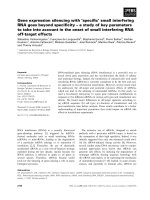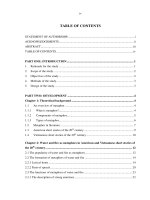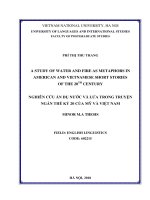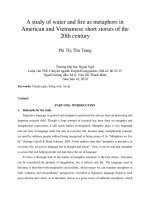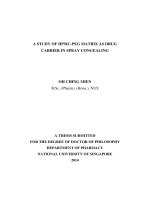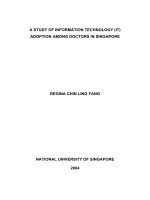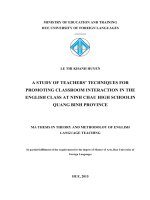A study of HPMC PEG matrix as drug carrier in spray congealing
Bạn đang xem bản rút gọn của tài liệu. Xem và tải ngay bản đầy đủ của tài liệu tại đây (3.79 MB, 200 trang )
A STUDY OF HPMC-PEG MATRIX AS DRUG
CARRIER IN SPRAY CONGEALING
OH CHING MIEN
B.Sc. (Pharm.) (Hons.), NUS
A THESIS SUBMITTED
FOR THE DEGREE OF DOCTOR OF PHILOSOPHY
DEPARTMENT OF PHARMACY
NATIONAL UNIVERSITY OF SINGAPORE
2014
ii
DECLARATION
I hereby declare that this thesis is my original work and it has been written by
me in its entirety. I have duly acknowledged all the sources of information
which have been used in the thesis.
This thesis has also not been submitted for any degree in any university
previously.
______________________________________________
Oh Ching Mien
31 July 2014
iii
ACKNOWLEDGEMENTS
First and foremost, I would like to extend my sincere gratitude to my
supervisors, Assoc. Prof. Chan Lai Wah and Assoc. Prof. Paul Heng, for their
continued stimulation of curiosity and their total dedication, guidance and
supervision. Without their inspiration and motivation, this work would not
have been possible.
My appreciation is also extended to the Head of Department, Assoc.
Prof Chui Wai Keung, for use of the facilities at the Department of Pharmacy,
National University of Singapore (NUS). I am also grateful to NUS for the
NUS Research Scholarship and NUS Industry Relevant PhD Scholarship.
I am grateful to Dr Kurup and Dr Celine Liew for their invaluable
advice during my candidature, Teresa and Mei Yin for providing excellent
technical assistance throughout my course of research and my fellow
GEANUSians, past and present, in particular Wong Xin Yi and Carin Siow,
for their ideas, help and friendship.
My deepest appreciation to my wife, Ker Yun, whose patience and
continual love encouraged me throughout this period and my son, Ethan, for
always giving me joy and good cheer. I also owe an immeasurable debt to my
family for their understanding and support. Finally, I would like to thank my
Heavenly Father for the grace and blessings, and without whom, I would not
be where I am today.
Ching Mien
July 2014
iv
TABLE OF CONTENTS
DECLARATION ii
ACKNOWLEDGEMENTS iii
SUMMARY ix
LIST OF TABLES xii
LIST OF FIGURES xiv
LIST OF ABBREVIATIONS xix
INTRODUCTION 2
A. Spray congealing 2
1. The process of spray congealing 2
2. Advantages and disadvantages 5
3. Influence of matrix materials 7
4. Influence of active pharmaceutical ingredients (APIs) 11
5. Influence of additives 14
B. Solid dispersions 19
1. Significance of solid dispersions 19
2. Crystallisation and amorphism 21
3. Screening of formulations using melting method 23
C. Modification of drug release 23
1. Design of modified release drug delivery systems 24
2. Advantages and disadvantages of modified release dosage form 26
3. Polyethylene glycols as matrix material 27
4. Excipients for drug delivery system modification 28
4.1. Hydroxypropyl methylcellulose 28
4.2. Methylcellulose 29
4.3. Ethylcellulose 29
4.4. Polyvinylpyrrolidone 30
D. Polymer rheology 30
1. Importance of polymer rheology in the pharmaceutical industry 30
2. Application of multivariate analysis in polymer rheology 31
HYPOTHESIS AND OBJECTIVES 34
EXPERIMENTAL 37
v
A. Materials 37
1. Active pharmaceutical ingredients 37
2. Matrix materials and additives 37
3. Dissolution media 38
B. Methods 38
1. Preparation of physical mixtures 38
2. Preparation of molten mixtures 38
3. Preparation of microparticles by melting method and milling 39
3.1. Preparation of solid dispersions 39
3.2. Conical screen milling of solid dispersions 39
4. Preparation of microparticles by spray congealing 40
5. Preparation of tablets with spray congealed microparticles 41
6. Characterisation of the physical mixtures, molten mixtures and
microparticles 42
6.1. Particle size analysis of particles produced by melting
method and milling 42
6.2. Particle size analysis of microparticles produced by spray
congealing 43
6.3. Determination of total yield and useful yield of spray
congealed microparticles 43
6.4. Assessment of morphology of microparticles 44
6.5. Swelling analysis of microparticles 44
6.6. Viscosity measurement of molten mixtures 45
6.7. Thermal analysis 45
6.8. X-ray powder diffraction (XRD) analysis 46
6.9. Raman spectroscopy 46
6.10. Fourier transform-infrared spectroscopy (FT-IR) 47
6.11. Determination of solubility of metronidazole in PEG 48
6.12. Determination of drug content and encapsulation efficiency 48
6.13. Construction of Beer-Lambert plot 49
6.14. Drug release study of microparticles 49
7. Characterisation of tablets 50
7.1 Tablet thickness 50
7.2 Tablet hardness 50
vi
7.3 Disintegration time 50
8. Statistical analysis 51
RESULTS AND DISCUSSION 53
Part I. Screening of matrix material and additives 53
A. Rheological properties of PEG with/without MNZ 54
1. Influence of molecular weight of PEG on viscosity 54
2. Influence of temperature on viscosity of the molten PEG
with/without drug 55
3. Influence of viscosity and PEG grade on drug crystallinity in
congealed matrix at different drug concentration 57
B. Crystallinity of PEG 59
C. Impact of different grades of PEG on MNZ stability in solid
dispersions 60
D. Rheological impact of additives on molten PEG 3350 61
E. Summary for Part I 63
Part II. Impact of HPMC on rheological properties of binary/ternary
PEG melt suspensions 64
A. Nature of PEG melt suspensions 64
B. Effects of various concentrations and grades of HPMC and
temperature 66
C. Effect of HPMC particle size 71
D. Effect of water content in molten PEG 79
E. Summary for Part II 81
Part III. Evaluation of polymer rheology using principal component
analysis 81
A. Assessment of principal component analysis as a suitable
analytical tool to evaluate viscosity profiles of melt suspensions 82
B. Evaluation of ternary polymer melt suspensions using principal
component analysis 87
C. Sprayability of ternary melt suspensions 90
D. Summary for Part III 90
Part IV. Impact of various grades and concentrations of HPMC on the
properties of congealed matrix with drug 91
A. Appearance of molten mixtures, solid dispersions and milled
particles 91
vii
B. Relationship between particle size and the mechanical properties
of congealed matrix with drug 93
1. Effect of HPMC concentration 93
2. Effect of viscosity 96
C. Effect of HPMC on MNZ crystallinity at high drug concentration 100
D. Summary for Part IV 102
Part V. Impact of HPMC on spray congealed PEG microparticles
with/without drug 103
A. Total yield and useful yield 103
B. Characterisation of spray congealed microparticles 106
1. Morphology of microparticles 106
2. Size and size distribution of microparticles 107
3. Solid state properties of MNZ in the spray congealed
microparticles 110
4. Drug content and encapsulation efficiency 123
C. Drug dissolution of MNZ 124
D. Summary for Part V 126
Part VI. Swelling effect of different grades and concentrations of
HMPC 127
A. Extent of swelling 128
B. Rate of erosion 133
C. Swelling effect on dissolution of rifampicin 136
D. Summary for Part VI 138
Part VII. Effect of HPMC on MNZ crystallinity in spray congealing
and during storage 138
A. Impact of HPMC particle size on MNZ crystallinity 138
B. Summary for Part VII 142
Part VIII. Modification of drug release from spray congealed
microparticles and the feasibility of developing the microparticles into
tablets 142
A. Dissolution of microparticles containing various additives 144
B. Screening of tablet formulations using manual tablet press 147
C. Optimisation of rotary tablet press parameters 150
D. Production and characterisation of MNZ tablets 151
viii
E. Summary for Part VIII 154
CONCLUSION 157
FURTHER STUDIES 161
REFERENCES 164
APPENDICES 177
LIST OF PUBLICATIONS AND PRESENTATIONS 180
ix
SUMMARY
Spray congealing has been used over 5 decades to produce particulates
by the food and pharmaceutical industries. The latter have used this
technology to develop specialised drug delivery systems with meltable
materials. Various types of polymeric admixtures and additives may be
incorporated into the melt carrier matrix to modify the final product properties,
in particular, the drug release.
In this study, various grades of polyethylene glycol (PEG) and types of
additives commonly used in formulating modified release dosage forms were
screened for their suitability as a meltable matrix and matrix modifier,
respectively, for spray congealing. The impact of grade and concentration of
selected additives on the properties of the molten mixtures, metronidazole
(MNZ), PEG matrix and spray congealed microparticles were investigated.
Suitable formulations were then selected for the production of spray congealed
microparticles, which were then compressed into tablets as the final dosage
form.
The grade of PEG used was found to affect the crystallinity and
thermodynamic stability of MNZ. Viscosity of the molten mixture had also
played an important role in affecting the crystallinity of MNZ. Screening of
the additives showed that hydroxypropyl methylcellulose (HPMC) was the
appropriate matrix modifier as it dispersed uniformly in molten PEG and the
molten mixture had low viscosity, which is amendable to spray congealing.
An understanding of the rheological behaviour of polymer melt
suspensions is crucial in pharmaceutical manufacturing, especially for spray
x
congealing. Rheological studies showed that the amount and particle size of
HPMC, besides temperature, affected the viscosity of PEG melt suspensions.
Using principal component analysis, the ternary melt suspensions consisting of
PEG, MNZ and HPMC of different grades were classified into three clusters,
namely low, moderate and high according to their final melt suspension
viscosities. The classification of formulation viscosities allows the selection of
an appropriate grade and concentration of HPMC to achieve the desired spray
viscosity for spray congealing. Formulations in the low viscosity cluster were
found to be the most easily sprayable.
The impact of various grades and concentrations of HPMC on the
properties of the PEG matrix and MNZ was subsequently studied using the
melt solidification method and by spray congealing. The addition of HPMC
decreased the size of the microparticles obtained, indicating a decrease in
mechanical strength of the PEG matrix. The reduction in MNZ crystallinity
was due to the presence of HPMC and not the viscosity of the molten mixture.
HPMC was successfully incorporated into spray congealed PEG-MNZ
microparticles. Spherical and free-flowing microparticles with good yield and
high encapsulation efficiency of MNZ were obtained. The HPMC
concentration influenced the viscosity of the molten mixture and size of the
resultant microparticles. Particle size of HPMC exerted a significant effect on
MNZ crystallinity. The amorphous and molecularly dispersed MNZ in the
microparticles was stable thermodynamically during storage.
The swelling extent of microparticles was influenced by the grade,
particle size and number of HPMC particles employed. Drug dissolution was
influenced by matrix erosion of the microparticles. A fast rate of erosion
xi
would result in increased drug dissolution and vice versa. Formation of the
barrier and the grade of HPMC used affected the rate of erosion of
microparticles and modified the release of rifampicin. Further modification of
drug release of spray congealed PEG-HPMC microparticles could be achieved
with the incorporation of other additives, such as dicalcium phosphate.
Formulation and operation parameters of the rotary tablet press for selected
spray congealed microparticles were optimised and tablets with suitable
hardness and disintegration time were successfully produced.
This research study provided insights into the impact of PEG and
HPMC as a drug carrier in the formulation of spray congealed matrix for
modulating drug release. The work also had contributed to a deeper
understanding of the effect of various grades and concentrations of HPMC on
the rheological properties of the molten mixtures and properties of PEG
matrix, MNZ and spray congealed microparticles, such as drug crystallinity
and matrix swellability.
xii
LIST OF TABLES
Table 1. Effects of various encapsulated active principles on the
properties of the microparticles. 14
Table 2. Formulations used for screening of various grades of PEG. 53
Table 3. Composition of ternary formulations of PEG melt suspensions 66
Table 4. Composition of binary and ternary formulations of polymer
melt suspensions. 83
Table 5. Different formulations containing various grades of HPMC and
their corresponding codes represented in PCA. 85
Table 6. Classification of various ternary formulations according to
viscosity profiles. 88
Table 7. Formulations containing PEG 3350 and MNZ with various
grades and concentrations of HPMC. 92
Table 8. Composition of molten mixtures and morphology of the spray
congealed microparticles produced. 104
Table 9. Composition of different spray congealed microparticles with
drug. 110
Table 10. Characteristic bands of single components in Raman and FT-
IR spectra. 121
Table 11. Drug content and encapsulation efficiency of various
formulations. 124
Table 12. Swelling extent for microparticles of size fraction 125 to 250
µm. 129
Table 13. Rate of erosion for microparticles of size fraction 125 to 250
µm. 134
xiii
Table 14. Formulations containing HPMC K15M of different mesh sizes
and median particle size. 139
Table 15. Reasons for chosen additives. 143
Table 16. Tablet formulations screened using manual tablet press. 148
Table 17. Properties of tablets composed of different microparticles. 152
xiv
LIST OF FIGURES
Figure 1. Distribution of drug within spray congealed particle. 3
Figure 2. Schematic diagram of the spray congealer. 4
Figure 3. An overview of the spray congealing process. 4
Figure 4. Schematic representation of three modes of incorporation of
the active principle in a solid dispersion. 19
Figure 5. Schematic illustration of (a) microparticle formed from spray
congealing and (b) mechanism of drug release from an eroding
microparticle. 25
Figure 6. Laboratory scale spray congealer. 40
Figure 7. Viscosity of different molecular weight PEGs at 80 °C. 54
Figure 8. Viscosities of molten mixtures of PEG: (a) without MNZ and
(b, c, d) with MNZ. 56
Figure 9. Viscosity of various formulations and the percentage reduction
in MNZ crystallinity of corresponding solid dispersions. 58
Figure 10. XRD spectra of different PEG grades before and after
subjecting to melting method. 59
Figure 11. Crystallinity of MNZ in P1500M, P3350M and P6000M
when freshly prepared and after storage for 3 months at 25 °C and 30 %
RH. 60
Figure 12. Appearance of molten PEG 3350 with PVP, HPMC, MC and
EC (from left to right). 62
Figure 13. Rheological profiles of molten PEG 3350 containing various
additives at 5 % concentration. 62
xv
Figure 14. Shear rate of molten PEG 3350 and molten mixtures
containing (a) 5 %, (b) 10 % and (c) 15 % HPMC with varying shear
stress at 70 °C. 65
Figure 15. Surface plots of log viscosity of PEG melt suspension with
temperature and HPMC concentration for (a) Methocel vLV, (b) F50
LV, (c) F4M, (d) E15 LV, (e) E50 LV and (f) E4M 68
Figure 16. Surface plots of log viscosity of PEG melt suspension with
temperature and HPMC concentration for (a) K100 LV, (b) K4M, (c)
K15M and (d) K100M. 69
Figure 17. (a) Median particle size (n=3) and (b) size distribution of
various grades of HPMC. 72
Figure 18. Line plots of melt suspension viscosities with increasing
temperature for (a) F-series, (b) E-series and (c) K-series. 73
Figure 19. Photomicrographs of HPMC (a) E15 LV, (b) E50 LV, (c)
E4M, (d) F50 LV, (e) F4M, (f) K100 LV, (g) K4M, (h) K15M, (i)
K100M and (j) Methocel vLV. 75
Figure 20. Particle size distribution of various HPMC K15M mesh size
fractions 78
Figure 21. Viscosities of PEG melt suspensions containing HPMC of
increasing particle size. 78
Figure 22. Viscosity of PEG melt suspensions consisting of 5 % HPMC
K15M and varying water content. 80
Figure 23. Viscosity profiles of the various formulations with increasing
temperature. 83
Figure 24. Scores plot of the viscosity profiles of binary formulations. 86
Figure 25. Scores plot of the viscosity profiles of ternary formulations. 87
xvi
Figure 26. (a) Molten mixture of PEG, MNZ and HPMC, (b) solid
dispersion removed from the refrigerator and (c) particles produced after
milling. 92
Figure 27. Median particle size and size span of MNZ-loaded PEG
microparticles produced with various HPMC concentrations: (a) E-
series; (b) F-series; (c) K-series and (d) Methocel vLV. 95
Figure 28. Viscosity of molten PEG mixtures comprising 20 % MNZ
and various HPMC concentrations of different grades: (a) E-series; (b)
F-series; (c) K-series and (d) Methocel vLV, at 80 °C. 98
Figure 29. Viscosity of the molten mixture at 80 ºC and resultant median
particle size and size span obtained from milling of solid dispersion. 99
Figure 30. Percentage reduction in drug crystallinity and viscosity of
molten mixtures comprising 20 % MNZ and various HPMC
concentrations: (a) E-series; (b) F-series; (c) K-series and (d) Methocel
vLV. 101
Figure 31. Total and useful yields of microparticles from different
formulations. 105
Figure 32. Photomicrographs of microparticles composed of (a) PEG
only; PEG with 15 % HPMC (b) K100 LV, (c) K4M, (d) K15M and (e)
K100M; (f) PEG with MNZ only; PEG with MNZ and 15 % HPMC (g)
K100 LV and (h) K15M. 106
Figure 33. Median particle size and viscosities of various formulations. 107
Figure 34. Scatter plot of microparticle size with increasing viscosity. 109
Figure 35. X-ray diffraction spectra of (a) single components and (b)
spray congealed microparticles and corresponding physical mixtures. 111
Figure 36. DSC curves of the (a) single components and (b) spray
congealed microparticles and corresponding physical mixtures. 114
Figure 37. Raman spectra of (a) PEG, (b) MNZ, (c) HPMC, (d) PM,
PMH
5
, PMH
10
and PMH
15
microparticles. 119
xvii
Figure 38. FT-IR spectra of: (a) PEG, (b) MNZ, (c) HPMC, (d) physical
mixtures PM*, PMH
5
*, PMH
10
* and PMH
15
* and (e) microparticles
PM, PMH
5
, PMH
10
and PMH
15
. 123
Figure 39. Dissolution profiles of various microparticles at pH 7.4: (a) as
a function of time and (b) as a function of log time. 125
Figure 40. Microparticles with (a) PEG only, (b) PEG and low
concentration of HPMC and (c) PEG and high concentration of HPMC.
Images shown are as follows: (1) before and (2) after contact with water,
(3) swelling to its maximum extent and (4) during erosion. 128
Figure 41. Surface plots of microparticle size and HPMC concentrations
with (a) swelling extent and (b) erosion rate for different HPMC grades. 131
Figure 42. Dissolution profiles of RIF powder and RIF-loaded
microparticles at pH 6.8. 136
Figure 43. Peak intensities in XRD spectra of various formulations
monitored over a period of 3 months at 25 °C and 30 % RH. 139
Figure 44. Scatter plot of drug crystallinity of various formulations. 140
Figure 45. Dissolution profiles of spray congealed microparticles with
various additives at 1 % concentration: (a) as a function of time and (b)
as a function of log time 145
Figure 46. Dissolution profiles of spray congealed microparticles with
various additives at 5 % concentration: (a) as a function of time and (b)
as a function of log time 146
Figure 47. Disintegration time for tablet formulations prepared using
manual tablet press. 149
Figure 48. Relationship of compression thickness with compression
force and tablet hardness. 151
Figure 49. Metronidazole tablets containing spray congealed
microparticles. 152
xviii
Figure 50. (a) Compression force, (b) ejection force and (c)
disintegration time of different tablets produced using the rotary tablet
press. 153
xix
LIST OF ABBREVIATIONS
Abbreviation Definition
API Active pharmaceutical ingredient
DCP Dicalcium phosphate
DSC Differential scanning calorimetry
EC Ethylcellulose
FT-IR Fourier transform-infrared
GIT Gastrointestinal tract
HCl Hydrochloric acid
HPMC Hydroxypropyl methylcellulose
MC Methylcellulose
MgSt Magnesium stearate
MNZ Metronidazole
PCA Principal component analysis
PEG Polyethylene glycol
PVP Polyvinylpyrrolidone
RH Relative humidity
RIF Rifampicin
SiO
2
Silicon dioxide
XRD X-ray diffraction
1
INTRODUCTION
2
INTRODUCTION
A. Spray congealing
1. The process of spray congealing
Spray congealing, also known as prilling, spray chilling or spray
cooling, is a process in which a hot molten mixture is atomised into a cooled
chamber where the molten droplets congeal to form solid particles. The molten
mixture consists of one or more active principles which may be melted,
dispersed or dissolved in a molten matrix material. The active principle,
matrix material and spray congealed particles are also referred to as drug/core,
carrier and microparticles respectively. Matrix material should exist as a solid
at ambient temperature and have a suitable melting point or range, typically in
the range of 50 to 100 °C. The transformation of molten droplets from liquid
to solid is usually achieved by the removal of heat energy from the droplets in
a cooled chamber. Congealing can also be accomplished by spraying the
molten mixture into liquid nitrogen, chilled organic solvent, desolvating liquid
or sorptive particles.
Spray congealing may also be considered as a method of
microencapsulation, where the active principle is embedded in the spray
congealed microparticle (Ghebre-Sellassie, 1989). If the active principle is
insoluble in the molten matrix, it will either be embedded at the core or
distributed in the matrix of the microparticle (Figure 1). If the active principle
dissolves in the molten matrix, it may exist as molecular dispersion in the
matrix on cooling. This technology has been used as the primary means of
microencapsulation for a wide range of pharmaceuticals, foods and flavours
(Deasy, 1984; Gibbs et al., 1999; Lee, 1981; Tobío et al., 1999) .
3
It can be employed to produce specialised drug delivery systems (Thies,
1996). With the proper selection of matrix material, the encapsulation process
can enhance stability (Bakan, 1973; Bakan and Anderson, 1976; Lin et al.,
1995; Maschke et al., 2007; Schwendeman et al., 1996; Sinha and Trehan,
2003; Taguchi et al., 1992; Wanasundara and Shahidi, 1995), increase
flowability (Lee, 1981), mask taste (Deasy, 1984; Yajima et al., 2002; Yajima
et al., 2003; Yajima et al., 1996; Yajima et al., 1999), reduce gastrointestinal
irritation (Frenkel et al., 1968) and/or alter release properties (Bodmer et al.,
1992; Deasy, 1984; Park et al., 2004; Passerini et al., 2003) of the active
principles. Over the last few decades, researchers had explored the application
of spray congealing to various matrix materials and active principles to
produce particles of different size, shape and solubility (Appendix 1).
Figure 1. Distribution of drug within spray congealed particle.
A schematic diagram of the spray congealer and the process overview
are shown in Figures 2 and 3 respectively. The matrix material is first heated
to a temperature of approximately 10-20 °C above its melting point and the
active principle(s) is/are then incorporated into the molten matrix material
with constant stirring to obtain a uniform mixture. The molten mixture is then
transferred by a conducting system to an atomiser where it is dispersed as a
4
Figure 2. Schematic diagram of the spray congealer.
Figure 3. An overview of the spray congealing process.
Chamber
Cyclone
Atomiser
Exhaust
Cool air
Fines collection
vessel
Feed
Product collection vessel
Air
Plenum
5
fine spray in a chamber. The molten droplets tend to assume a spherical shape
due to the effects of surface tension and state of air suspension. They are
cooled to temperatures below the melting point of the matrix material by cool
air. Heat is removed from the molten droplets, resulting in their congealation
to form solid spherical particles. The larger particles are collected in a vessel
below the cooling chamber while very fine particles are conveyed with the
exhausting air flow to a cyclone where they are separated from the air stream
and collected in another collection vessel. Alternatively, all the spray
congealed particles are conveyed to the cyclone. The residence time for
sprayed droplets in the cooling chamber is usually short, ranging from several
seconds to a few minutes. Typically, the spray congealed product consists of
dense round spheres of less than 1 mm in diameter, which can adeptly be
called microparticles, micropellets or microspheres.
2. Advantages and disadvantages
Both spray drying and spray congealing involve the atomisation of
liquid feed to eventually produce solid particles. In spray drying, a solution or
suspension containing the active principle and/or excipient is sprayed into a
stream of hot air. The particles produced using spray drying technique
generally have irregular geometry and porous surfaces due to the evaporation
of solvent, typically water or ethanol (Ghebre-Sellassie and Knoch, 1995).
Thus, any coating attempts by spray drying may be adequate for taste masking
and other purposes but not for controlled drug release (Deasy, 1984).
Conversely, particles produced using spray congealing are generally dense,
spherical and smooth surfaced as there are no internal evaporative effects on
6
the spray congealed products (Hincal and Kaş, 1994). The properties of spray
congealed particles make them highly suitable for secondary processing such
as tabletting and capsule filling. Several researchers had also reported that
spray congealed particles possessed desirable sizes and shapes, high drug
encapsulation efficiency and exhibited acceptable syringeability/injectability
(Deng et al., 2003; Li et al., 2005). Another advantage of spray congealing
technique is that microparticles can be prepared without water or organic
solvents (Reithmeier et al., 2001; Rodriguez et al., 2004). This makes spray
congealing an environmentally friendly process that is attractive for the
processing of moisture sensitive drugs. It also eliminates the drying step and
the risk and toxicity associated with organic solvents (Witschi and Doelker,
1997). The microparticles can also be collected and processed immediately
after production, without the need for additional processing steps (Janssens
and Van den Mooter, 2009).
A major disadvantage of spray congealing is that the active principles
and additives included must be stable at the temperature required to melt and
maintain the matrix material in molten form (Turton and Cheng, 2006). This
limits the choice of matrix material for thermolabile drugs such as
erythromycin, acyclovir and isotretinoin. Furthermore, the choice of matrix
material is also constrained by the melting temperature which may be too
high. Examples of materials which have very high melting temperature and
unsuitable for use are mannitol (m.p. 166 to 168 °C) and sucrose (m.p. 160 to
186 °C). Some matrix materials such as glycerides and carnauba wax may
undergo physical changes during the process, which can affect the stability
and dissolution of the drug (Eldem et al., 1991; Emås and Nyqvist, 2000). The

